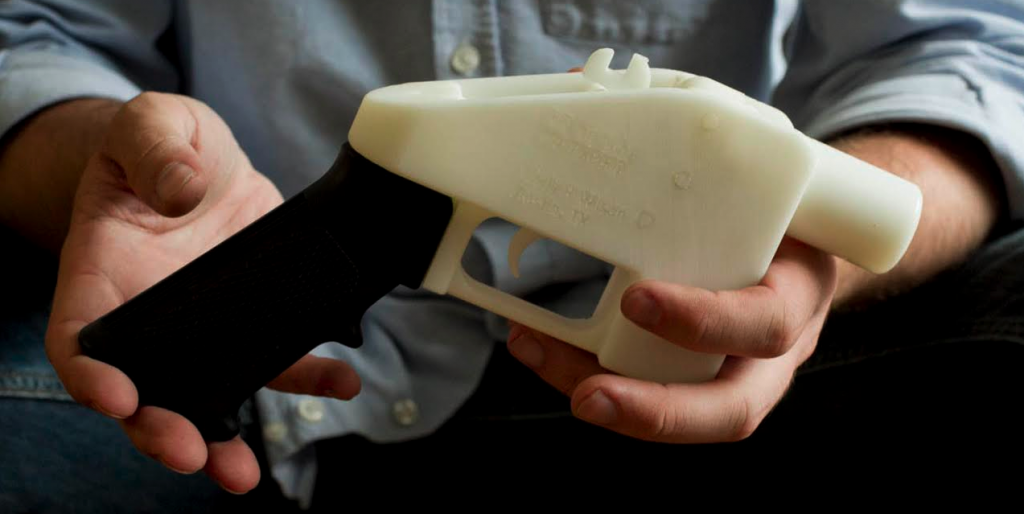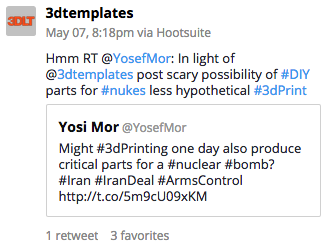Back in January 2013 we were planning the launch of 3DLT. We wanted to kick things off with a bang (apologies in advance for that). Crowdsourcing was an important part of our model. We wanted independent designers to submit CAD designs that we could sell on our site.
We identified two tools in those early days which we thought could help build awareness and inspire the industrial designers, mechanical engineers, animators and makers we were targeting (sorry, another one). First, we could run monthly “theme drives” to help fill out specific product categories. Second, we could hold “innovation challenges” with the goal of solving big, world problems.
For our first innovation challenge, we kicked around a bunch of ideas like accessible water, concussions in sports, and others. But at that time, 3D printed guns were starting to get a lot of attention. We thought it could be smart to demonstrate that whatever evil a technology could spawn, it could bring an equal amount of good. So, we decided to launch a crowdfunding campaign to raise money to hold an innovation challenge to create products that would improve gun safety.
Fast forward a few years, and we routinely publish and share content through our various social channels. A few weeks ago, we posted an article about how 3D printers are being used to create parts for airplanes. Someone responded with this:
Which got me thinking. Could the dark side be even more evil than 3D printed guns? Could digital technology actually democratize the manufacturing of way more powerful weapons, creating an entirely new and very scary war of escalation?
Now, I am definitely not trying to raise any alarms here, or for that matter give anyone any dumber ideas than they already have, but since it was put out there I felt it needed to be addressed.
Is It Possible?
So the first question I needed to answer was…is any of this even possible? I reached out to my good friend Greg Morris for answers. Greg was previously the CEO and owner of Morris Technologies. Morris was one of the global leaders in metal laser sintering. A couple years ago his company was acquired by GE Aviation and he now works for them.
There may be no better authority on the planet when it comes to 3D printing highly complex metal parts. So, I asked him about the skill and technology it takes to produce parts for the aerospace industry.
“3D printing can be used to print any number of objects,” Greg replied. “That being said, for critical applications such as aircraft engine components, the level of quality required to produce parts that are certified is quite daunting. GE Aviation has spent 10’s of millions of dollars qualifying not only the additive process, but also the materials, inspection techniques and adjacent technologies that together provide us the confidence and assurance that parts we make additively will perform in the extremely harsh environment of a gas turbine engine.”
Maybe building a bomb or other weapon isn’t as involved as building a jet engine, but it would still require some pretty complex fabrication. If you were going to 3D print parts, you’d need high-end devices and the adjacent finishing technology. The equipment is large and the cost is prohibitive. You’d also have significant work to do on the materials side.
Thinking this could happen in a cave on a mountain somewhere in Afghanistan is a bit far-fetched.
Is It Practical?
That’s one of the big debates surrounding Cody Wilson’s Liberator and other more recent designs. There is significant fear that they could democratize production of firearms. Well, just because something could be done, doesn’t mean it would. For a lot less money and with less work and fewer tools you could build a zip gun from basic supplies found at your local hardware store.
I’ve also heard people say that because the files are free to download and 3D printed guns aren’t being offered for sale, they don’t have to be registered. While that may be true – theoretically at least – neither does any other firearm made by an individual, whether that be a zip gun or a professionally machined piece.
But, here’s the reality. Even if you wanted to register (or ban) 3D printed guns, it’s not practical. The files have already been shared and the printers already exist.
Is It Invisible?
Another concern with the 3D printed gun is the fact that it’s made mostly of plastic (although the Liberator does use a common metal roofing nail as the firing pin). As a result, it is supposedly easier to get through security.
Recently an investigation by the US Transportation Security Administration (TSA) found that undercover agents posing as passengers were able get weapons past TSA agents in 67 out of 70 tests — a 95 percent failure rate!
So, Congress feels compelled to act…against 3D printed plastic guns (which were NOT used in the investigation).
“What angers me, and frankly what frightens me,” said Representative Steve Israel (D – NY), “is that the guns that were getting past the TSA agents were highly detectable. But a plastic gun couldn’t be picked up by the most astute and trained TSA agent.”
It seems that Representative Israel is blaming a technology that had nothing to do with either the cause (poor security) or the effect (guns and explosives getting through 95% of the time). Maybe it would better to focus on fixing the real problem…TSA’s failure to detect REAL guns.
And, let’s not forget that like traditionally manufactured firearms, the Liberator uses METAL bullets, which would also have to get through security to be of any use. On some file marketplaces, people do post models of bullets which appear to be made of plastic, but they’re not operable. Like the Liberator, every other 3D printed gun I’ve seen fires conventional ammo.
Dangerous Thinking
The same kinds of problems occur with other weapons that could theoretically be 3D printed. First, in most cases it wouldn’t be practical. Mass produced components are readily available and would probably be a better option. Things that aren’t (like fissionable material) can’t be 3D printed anyway.
If someone were to create a device, they would be way more likely to use conventional, readily available materials. Remember the Boston Marathon bombings? They used store bought pressure cookers. How about the guy who bombed the Federal Building in Oklahoma City? He rented a truck and filled it with diesel fuel and fertilizer.
Opportunities in Innovation
I think it’s way more important to focus on the positives of a technology like 3D printing. Recently, we conducted a survey of over 4,600 consumers and asked what about 3D printing seemed most interesting to them. Nearly half said:
“It helps makes products available that might not be otherwise.”
What kinds of products? Well, we asked that too. While some were interested in everyday consumer goods, others told us they were more interested in medical devices, prosthetics and items that improve their health and the safety of their children and households.
Simply put, there is a lot of potential in 3D printing’s ability to unlock innovation.
There are hundreds of startups working in the space to accomplish exactly those outcomes. They can use all of the support they can muster. It’s a huge opportunity for politicians to prove Ronald Reagan wrong when he famously said, “The nine most terrifying words in the English language are, I’m from the government and I’m here to help.”
So instead of clamoring for laws that are illogical and impractical, maybe our lawmakers should seek to foster the positive outcomes 3D printing and other digital manufacturing technologies can provide.
How? By getting resources to 3D printing startups that are developing those innovative new products.
Mic dropped.
About the author: John Hauer is the CEO of 3DLT, a platform for 3D Printing As-a-Service. The firm works with retailers and their suppliers, helping them leverage 3D printing online and in-store. 3DLT sources the content, provides the technology, and manages the fulfillment of 3D printed goods. John is a noted thought leader on 3D printing and his content has been featured on TechCrunch, QZ.com, Techfaster.com, 3DPrint.com, and Inside3DP.com, among others. Follow him on Twitter @3DLTJohn
Subscribe to Our Email Newsletter
Stay up-to-date on all the latest news from the 3D printing industry and receive information and offers from third party vendors.
You May Also Like
3D Printing Webinar and Event Roundup: April 7, 2024
Webinars and events in the 3D printing industry are picking back up this week! Sea-Air-Space is coming to Maryland, and SAE International is sponsoring a 3D Systems webinar about 3D...
Roboze Brings Performance Polymer 3D Printing to SoCal via New Partnership
High-performance polymer 3D printing firm Roboze has been steadily working to expand its global footprint, with a firm eye on distributed manufacturing, particularly with regard to the oil and gas,...
3D Printing Webinar and Event Roundup: March 3, 2024
In this week’s roundup, we have a lot of events taking place, including SPE’s ANTEC 2024, Futurebuild, the AAOP Annual Meeting, JEC World, and more. Stratasys continues its training courses,...
Advanced Manufacturing Firm Zeda Acquires The Orthopedic Implant Company
Zeda, the San Francisco-based provider of advanced manufacturing solutions, announced that it has acquired The Orthopedic Implant Company (OIC), a medical device manufacturer based in Reno, Nevada, for an undisclosed...


































